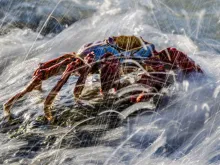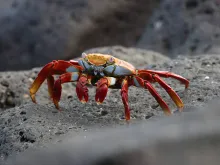There are three species of puffin in the genus Fratercula, family Alcidae, and they all share certain characteristics — small and stocky bodies, black and white plumage, large bills, and orange-red feet. It’s easy to confuse these adorable birds at first glance, but if you look carefully for a few clues you can quickly determine whether it’s a Horned, Tufted, or Atlantic Puffin.
*

The Tufted Puffin never clowns around
Tufted Puffin (Crowned Puffin)
Scientific name: Fratercula cirrhata
Where you’ll find them: Northern Pacific: Alaska, British Columbia
Distinguishing features: The easiest of the puffins to identify, the Tufted Puffin lives up to its name with thick yellow tufts above its eyes that resemble a crown (or some fierce statement eyebrows). Tufted Puffins also have a much smaller patch of white on their faces, narrower bills, and rounder, paler eyes when compared to Horned and Atlantic Puffins. They are the largest of the puffins, averaging around 1.5 lbs with a 25 inch wingspan.
*

Hungry hungry Horned Puffin
Horned Puffin
Scientific name: Fratercula corniculata
Where you’ll find them: Northern Pacific: Alaska, Siberia, British Columbia
Distinguishing features: Though similar in appearance to the Atlantic Puffin, there are a few things that will help you identify a Horned Puffin. Firstly, this species named after the black fleshy “horn” pointing up vertically from the top of its eye. Its bill is pale yellow at the base and orange at the tip, but broader than the bill of the Tufted Puffin, and although somewhat closer in shape, it’s much rounder when compared to the sharp triangular bill of the Atlantic Puffin. The Horned Puffin averages 1.3 lbs and has a wingspan of approximately 23 inches.
*

Atlantic Puffin: Cute Puffin or Cutest Puffin?
Atlantic Puffin (Common Puffin)
Scientific Name: Fratercula arctica
Where you’ll find them: Northern Atlantic: Iceland, British Isles, Greenland, Norway, Newfoundland
Distinguishing features: Hint number one: If you’re in Iceland, it’s an Atlantic Puffin. Besides being the only species you’ll find in the Atlantic, these cute little birds are nicknamed the “clowns of the sea” because of their comical waddle, colorful triangular eyes, and bright orange-red bills and feet. In addition to their vivid coloring, their bills have a silvery grey base and are more triangular and flat than those of their Pacific cousins. These are the smallest of the puffins by far, with an average wingspan of 21 inches and an average weight of 13 oz.
*

Can you see the difference?
Want to see puffins for yourself? Click here to learn about our upcoming trip to Denali and Kenai with Audubon Alaska.











